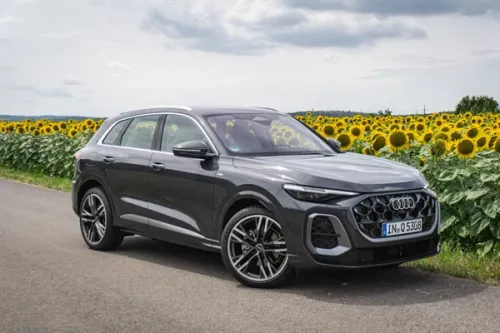New Ford Focus RS - in detail
Six years have passed since the last Ford RS - the Mk1 Focus RS - finished its strictly limited production run. Now the famous badge has returned for its league of devoted fans and a new generation of performance car enthusiasts.


[B]RS - A Significant Event[/B]
This new Focus RS is the product of Ford Team RS, headed by Jost Capito, a committed car enthusiast and racer. Alongside Capito is a small team of dedicated performance car and motorsport engineering specialists, led by Chief Programme Engineer, John Wheeler, whose own expertise stretches over 20 years of Ford performance and motorsport vehicles.
Team RS works hand-in-hand with Ford of Europe experts from across the engineering spectrum to create Ford's performance road car range. More than 100 engineers have been involved in Focus RS and every one understood the weight of expectation that greets a new Ford RS model.
States Capito: "A new Ford RS is a significant event; the badge is not applied to a new car very often and when it is, it has to be a great car. I know this Focus RS will be thoroughly deserving of the name."
From early in its development programme, the team set a target to create a car with the poise, power, performance and precision to trade lap times with far more exotic vehicles and be a benchmark for performance and value for money.
Their result is a car capable of lapping the legendary 20.8km (12.3 mile) Nurburgring Nordschleife repeatedly at speed and equally adept at cruising home afterwards; blending Ford Focus practicality with bespoke engineering, dynamics and a turbocharged, 300 bhp 2.5-litre Duratec engine.
[B]Starting Point[/B]
Defining performance parameters of the new Focus RS began before the last Mk1 Focus RS left the production line. Perhaps surprisingly, that work didn't involve the name 'RS' at all, for the group was concentrating then on fine tuning the latest Focus ST model.
"In developing Focus ST, we reached 222 hp and 320Nm torque with the 2.5-litre Duratec and the outstanding Focus chassis handled it comfortably. This was already 10 hp more than the previous Focus RS. ST re-framed what we and our customers could expect of a new RS and it became an excellent development base," explains John Wheeler.
The team's other benchmark was the previous-generation Focus RS, and here their own opinions and analysis was augmented by the views of owners.
"We're in regular contact with RS owners and enthusiasts across Europe and their views helped shape our own. The previous Focus RS was created to give that limited edition, 'World Rally car for the road' feel, which made it an extreme experience. We didn't just want to repeat that formula for new Focus RS and the views and requirements of RS fans were incredibly helpful in creating this car's everyday side," Wheeler continues.
The result was a short but complicated set of priorities: the pace and performance feel of the previous RS, but with even more power and greater stability; durable circuit performance, but with greater comfort for everyday driving.
Research work began in earnest, while the timing for introducing the high-performance model was considered. By 2008, Ford of Europe's flexible manufacturing strategy had created the ability to build low volume vehicles efficiently and there were several key milestones to mark.
"Our flexible manufacturing and the use of shared commodities really helps to produce vehicles like Focus RS, without having to make large manufacturing investments or build off-line," adds Capito.
"The 2009 production start for Focus RS has marked the 10th anniversary of Ford Focus and 40 years of Ford RS, backed by two consecutive World Rally Manufacturers' Championship titles. Combined, these factors make the creation of the new Focus RS very appropriate," he continues.
[B]Dolphin and Shark[/B]
From NVH to design, powertrain to safety, Ford specialists from across the engineering spectrum were involved with Focus RS, needing to understand quickly its requirements and attributes and the differences in philosophy between the 'ST' and 'RS' brands.
To illustrate the fundamental differences of approach between an ST and an RS, the Team RS engineers created the analogy of 'Dolphin and Shark'.
Capito explains: "ST and RS should be different animals, as are a dolphin and a shark. Both are highly developed for their roles but have unique characteristics - ST is a balance of performance and refinement, but would not fit the attributes we set for RS and vice versa. It's surprising how much we used this analogy."
Those attributes for Focus RS were developed from a definition of "the ultimate production Focus." In keeping with its heritage, RS is an even more performance-oriented vehicle than ST, developed in every detail with on-track performance of equal importance to on-road behaviour. An exhaustive set of individual criteria was created for every aspect of the car's performance, dynamics and durability, a process similar in scope to that required for a whole new carline.
However, for all the differences, there is one area of common ground between Focus ST and RS. Both are front-wheel-drive, one of the first decisions taken in the development of RS and explained by Team RS Chief Engineer, Dirk Densing:
"Front-wheel-drive was our preference all along. All-wheel-drive systems add cost, weight, inertia and consequently, fuel consumption. Compensating for the significant weight of an all-wheel-drive system requires dynamic compromises we preferred not to make. If you can achieve the performance you want without steering disturbance, then front-wheel-drive is a better performance car - lighter and with a more precise, linear steering response than AWD. With the work of our advanced research team in Aachen, we were able to achieve this and deliver something genuinely different," he says.
[B]Great Focus Heritage[/B]
In being both a genuine Ford RS and a full member of the Focus family, the new Focus RS represents a significant moment in the legacy of both brands.
The year 2008 marked 10 years since the Ford Focus was first revealed to the world at the Geneva Motor Show in 1998, paving the way for a range of Ford vehicles whose exciting design was matched by class-leading driving quality.
Since this time, more than 5.5 million Ford Focus models have been built in Europe, including Russia, with the car also built and sold in North America, Asia and South Africa.
Now, the latest generation Focus also wears the famous Ford RS badge with pride, continuing a distinguished heritage that can trace its roots back 40 years and encompasses a wide range of Ford models.
"RS is central to Ford's high-performance heritage and Focus has played a major part in establishing Ford's excellent reputation for driving dynamics. The all-new Focus RS embraces and celebrates both of these - a genuine RS and a genuine Focus," concludes Capito.
[B]Focus RS Power[/B]
The turbocharged Duratec RS 2.5-litre engine creates Focus RS' distinctive character, delivering its peak power of 300 bhp at 6,500 rpm and peak torque of 440Nm between 2,300 and 4,500 rpm.
[B]Power Generator[/B]
The Focus RS engine shares its fundamental structure with that of Focus ST, but there the similarities end. Powertrain manager Len Urwin knew from the beginning that simply adjusting the engine management system for more power would be insufficient for a true RS.
He explains: "There was never an intention to try to 'chip' the ST engine. We evaluated several approaches using the ST engine and none gave us the combination of power delivery, character and durability that we wanted, so we opted to create an RS Duratec, using the ST unit as our base."
The objective was increasing power and torque without affecting durability. To meet that, multiple detail changes were made to the powertrain including a revised cylinder head gasket, ultra-durable metal sprayed cylinder bores, revised pistons and a bespoke camshaft profile and connecting rods, allowing bigger small end bearings.
However, the most obvious changes are the new intake system, exhaust manifold and turbocharger. The larger Borg Warner K16 turbo fitted to Focus RS offers a maximum steady state boost pressure of 1.4 bar - double that of Focus ST's 0.7 bar - to generate the car's 35 per cent power increase.
[U]Committed to maintaining responsiveness of the engine, Urwin's team focused on three areas:[/U]
1. Integrating the turbo with the exhaust manifold, to allow subtle manifold tuning and strategically locating the turbo in the engine bay, to optimise crash performance and minimise revision to the exhaust system and associated oil and water pipes;
2. Carefully sizing the required larger turbo, to closely match the 'bottom end' engine responsiveness of Focus ST;
3. Reducing the induction system and exhaust losses.
Focus RS needed its own, more aggressive performance character so engineers also modified the torque 'ramp-up', to enhance performance feel when on boost.
"While we wanted to be equal on low-end responsiveness and minimise the common off-boost inertia of larger turbos, we didn't want RS to have the same character as ST," explains Urwin. "We wanted a stronger feel of increasing boost; we wanted you to really feel the surge of the turbo."
With the turbo spinning, power arrives quickly. The 305PS peak is reached at 6,500 rpm and holds until the 7,050 rpm redline, to allow full use of the top of the power band. After three seconds at this redline, the engine management system recognises no gear shift and then limits revs to the car's maximum continuous running rpm of 6,500.
"Turbo engines with flat torque curves can often feel like they run out of steam at the top-end, but we wanted to reward drivers who took Focus RS to the red line," states Urwin. "We're really proud of the result - strong mid-range transient response and a free revving top-end."
[B]Bespoke Transmission[/B]
That combination of performance ability and cruising capacity is made practical by a specially-developed, six-speed Ford RS transmission. It shares its gear ratios with the Focus ST gearbox on which it is based, with minor modifications to bearings and clutch housing and a revised, stronger differential.
Overall, gearing is one per cent longer than ST due to the larger rolling circumference of Focus RS' specially developed tyres - further evidence of the team's attention to every detail.
This allows gearing long enough for Focus RS to reach the all-important 100 km/h barrier in second gear.
[B]Differential Difference[/B]
Putting the torque on the road is aided by a Quaife helical limited slip differential. The Quaife differential was first developed for the original, five-speed Focus RS in 2002, but revised and improved by Ford Team RS for the new, six-speed Focus RS. Today, it features a sixth planet gear and has been revised for increased strength and a more subtle intervention and torque transfer.
Computer-aided engineering drove the design of the differential, identifying the potential areas for increased strength. This was aided by measuring rig work and whole vehicle development, with particular attention to refining performance plots for the differential's torque bias function, to maximise dynamic performance.
Concludes Urwin: "We have tuned the differential for a progressive torque transfer. Our work was focused on creating an optimum drive for both road and track, in the dry and the wet. It was in finding this balance that our tuning efforts were directed."
[B]Inconspicuous Consumption[/B]
All the work carried out in fine-tuning the design and specification of the Focus RS in terms of aerodynamics, powertrain details and chassis set-up not only assisted the car's precise dynamic response and performance, but also the everyday consideration of its fuel economy and emissions.
For a 300 hp high-performance car, Focus RS is remarkably efficient, with European Driving Cycle combined fuel economy of 9.4 litres per 100km and an average CO2 rating of 225 grams per kilometre1.
Combined with a larger, 62-litre fuel tank (up from 55 litres in other Focus models), this gives Focus RS a healthy driving range.
"It was important for us to develop a vehicle which combines high performance with fuel economy. In the 300+ hp category, Focus RS is amongst the leaders for fuel economy," comments Wheeler.
[IMG]http://www.oneshift.com/showroom/uploadimages/resized-20090129192327015.jpg[/IMG]
[IMG]http://www.oneshift.com/showroom/uploadimages/resized-20090129192307936.jpg[/IMG]
[IMG]http://www.oneshift.com/showroom/uploadimages/resized-20090129192247920.jpg[/IMG]
Credits: JRC


Get the Best Price for your used car
from 500+ dealers in 24 hours

- Convenient and Hassle-Free
- Consumer Protection
Transparent Process
With No Obligation








